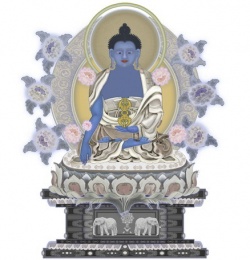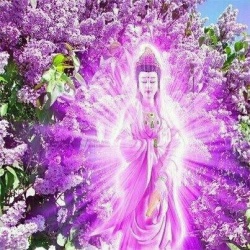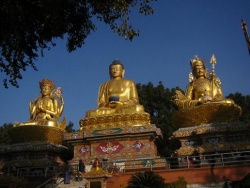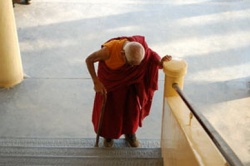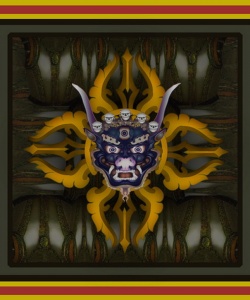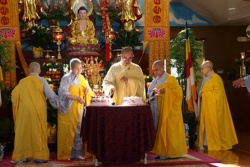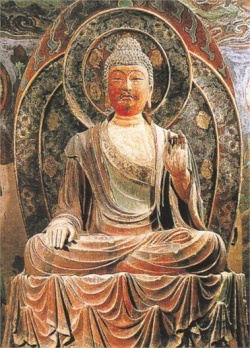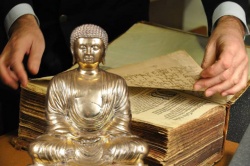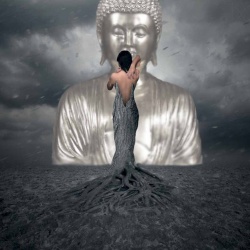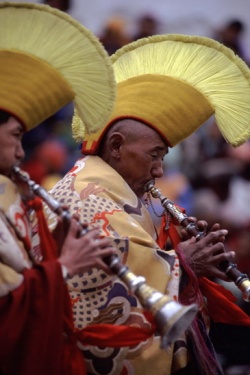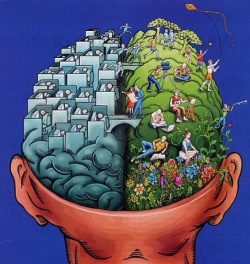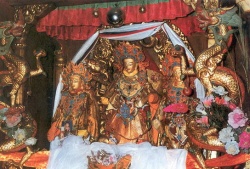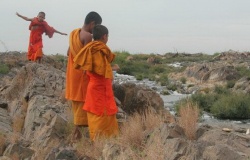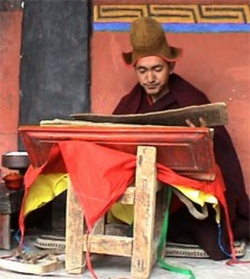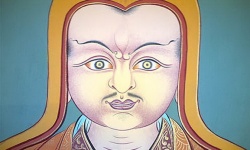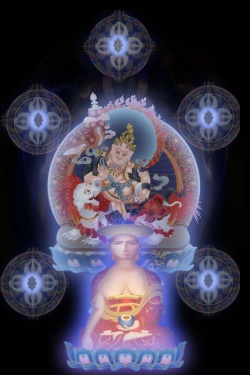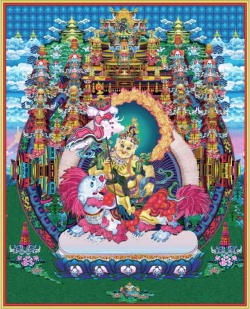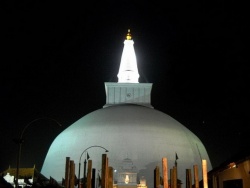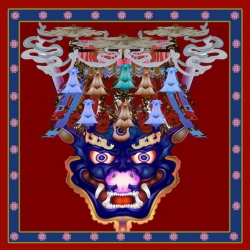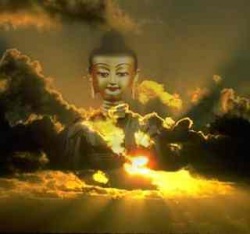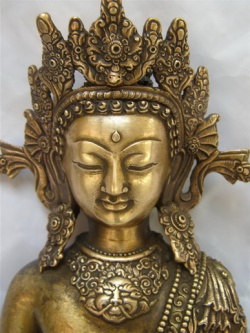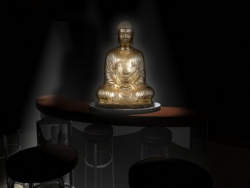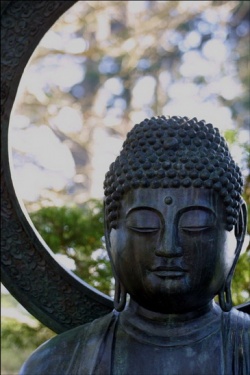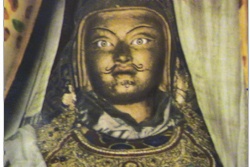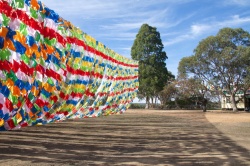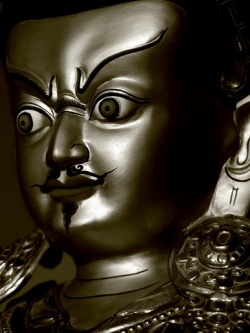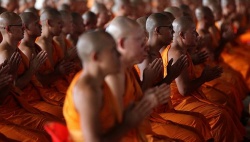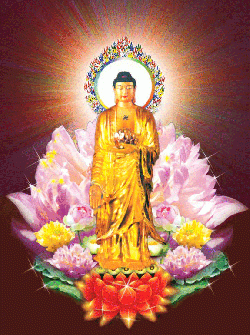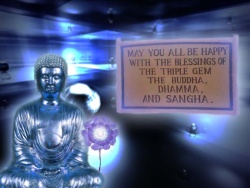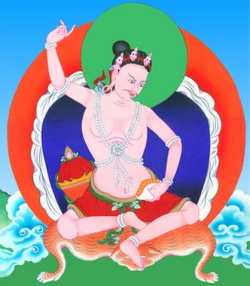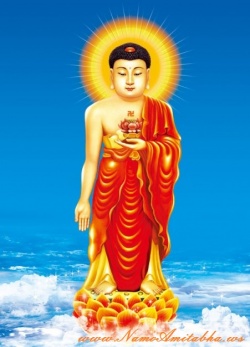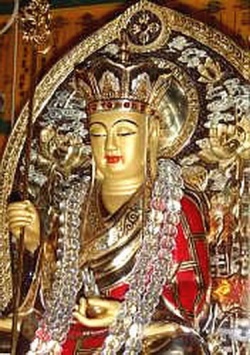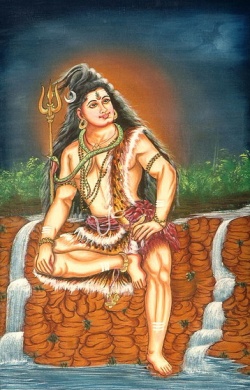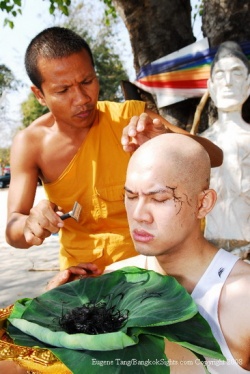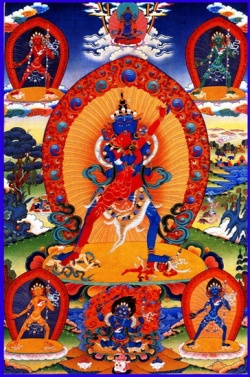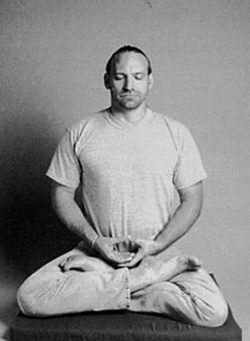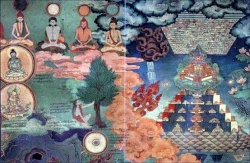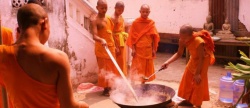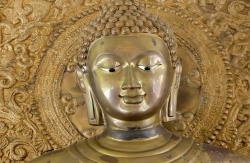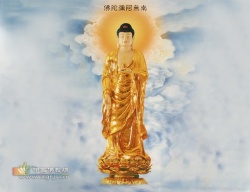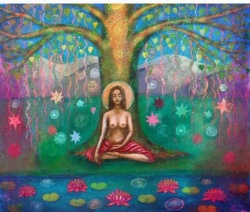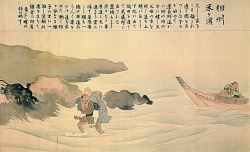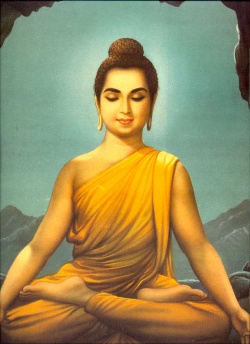Majjhima Nikaya
Majjhima Nikaya
Collection of Medium Length Discourses of the Buddha.
This collection of medium length discourses is made up of one hundred and fifty two suttas in three books known as pannasa. The first book, Mulapannasa, deals with the first fifty suttas in five vaggas, the second book, Majjhimapannasa consists of the second fifty suttas in five vaggas too; and the last fifty two suttas are dealt with in five vaggas of the third book, Uparipannasa, which means more than fifty.
The suttas in this Nikaya throw much light on the social ideas and institutions of those days, and also provide general information on the economic and political life.
(a) Mulapannasa Pali
I. Mulapariyaya Vagga
(1) Mulapariyaya Sutta
The Buddha explained the basis of all phenomena, specifying twenty four categories such as the four elements (earth, water, fire, wind); sentient beings, devas; the seen, the heard, the thought of, the known; the oneness, the multiplicity, the whole; and the reality of Nibbana. The uninstructed worldling cannot perceive the true nature of these phenomena; only the enlightened ones can see them in true perspective.
(2) Sabbasava Sutta
In this discourse, mental intoxicants that beset the uninstructed worldling are defined, and seven practices for eradicating them are explained.
(3) Dhammadayada sutta
This sutta contains two separate discourses, the first one given by the Buddha, the second by the Venerable Sariputta. The Buddha urged the bhikkhus to receive as their legacy from him the Bodhipakkhiya Dhamma only, and not material things like the four requisites. The Venerable Sariputta advised the bhikkhus to lead a solitary life for attainment of jhana and to strive for the attainment of Nibbana by abandoning greed, ill will, and delusion.
(4) Bhayabherava Sutta
This discourse describes how a bhikkhu leading a solitary life in a secluded forest invites harm and danger to himself by his impure thoughts, words and deeds, and how the Buddha had lived a peaceful forest life harmlessly by cultivating pure thoughts, words and deeds which finally led him to enlightenment.
(5) Anangana Sutta
In this discourse given on the request of the Venerable Maha Moggallana, the Venerable Sariputta explained four types of individuals:
(i) an impure person who knows he is impure;
(ii) an impure person who does not know he is impure;
(iii) a pure person who knows his own purity;
(iv) a pure person who does not know his own purity.
(6) Akankheyya Sutta
This sutta describes how a bhikkhu should develop sila, samadhi and panna, instead of hankering after gain and fame; how he should restrain his faculties, seeing danger in the slightest fault.
(7) Vattha Sutta
In this discourse the Buddha explained the difference between an impure mind and a pure mind by giving the example of dirty cloth and clean cloth. Only the clear cloth will absorb dye; so also only the pure mind will retain the dhamma.
(8) Sallekha Sutta
In this discourse the Buddha explained to Maha Cunda how wrong views about atta and loka can be removed only by vipassana insight. Jhanic practice is not the austerity practice that removes moral defilements; jhanic practice only leads to a blissful existence. Only refraining from forty-four kinds of bad deeds constitutes austerity practice for removing moral defilements. The volition alone to do a good deed is enough to produce a good result; when it is accompanied by the actual deed, the beneficial result accruing is immeasurable. One immersed in the mire of sensuous impurities cannot rescue others immersed likewise in the mire.
(9) Samma-ditthi Sutta
This discourse is an exposition on the right view delivered by the Venerable Sariputta at Savatthi. When physical, verbal and mental actions are motivated by greed, hatred and delusion, they are deemed to be bad. When they arise through non-greed, non-hatred and non-delusion, the actions are deemed to be good. Right View is understanding what a good deed is and what a bad deed is; it is the full comprehension of the Four Noble Truths and not holding on to eternity views concerning atta.
(10) Mahasatipatthana Sutta
This discourse given at Kammasadhamma market town is the most important sutta which gives practical guidance for cultivation of mindfulness. It describes the Four Methods of Steadfast Mindfulness, namely, contemplating the body, contemplating sensation, contemplating the mind, and contemplating the dhamma as the one and only way for the purification of beings, for the overcoming of sorrow and lamentation, for the complete destruction of pain and distress, for the attainment of the Noble Magga and for the realization of Nibbana.
This sutta appears in identical form in the Digha Nikaya.
II. Sihanada Vagga
(1) Culasinhanada Sutta
In this discourse, given at Savatthi, the Buddha made the bold statement that the four Categories of Ariyas, namely;
the Stream-winner,
the Once-returner,
the Non-returner and
the Arahat exist only in his Teaching and not in any other.
(2) Mahasihanda Sutta
In this discourse, given at Vesali, the Venerable Sariputta reported to the Buddha about the disparagement of the Buddha's virtues made by Sunakkhatta who had left the Teaching. The Buddha said that Sunakkhatta was not intellectually equipped to have the faintest glimpse of the Buddha's virtues such as the Ten Strengths, the four kinds of supreme Self-Confidence, the Non-decline of Sabbannuta Nana till the time of parinibbana. He then described the five destinations and the actions which lead to them as well as the wrong beliefs and practices of the naked ascetics to whose camp Sunakkhatta now belonged.
(3) Mahadukkhakkhandha Sutta
This discourse was given at Savatthi to refute the naked ascetics when they tried to make out that they followed the same path and taught the same dhammas the Buddha. The Buddha also explained to the bhikkhus what the pleasures of the senses wore, what their faults and dangers were, and the way of escape from them. The Buddha explained further that outside of his Teaching, these dhammas were not known and no one but the Buddha and his disciples could teach such dhamnas.
(4) Culadukkhakkhandha Sutta
This discourse, given by the Buddha, at Kapilavatthu to the Sakyan Prince Mahanama to explain to him on his request, how greed, ill will and ignorance caused moral defilements and suffering.
(5) Anumana Sutta
This discourse was given by the Venerable Maha Moggallana to many bhikkhus at Susumaragira in the country of Bhagga. They were urged to see if they had purged themselves of sixteen kinds of stubbornness such as inordinate desire, humiliating others while praising oneself, wrathfulness, etc. If these sixteen kinds of unwholesome dhammas were detected in oneself, a determined effort should bo made to get rid of them.
(6) Cetokhila Sutta
This discourse, given by the Buddha at Savatthi, mentions the five kinds of mental thorns: doubt about the Buddha, doubt about the Dhamma, doubt about the Sahgha, doubt about the efficacy of the practice in sila, samadhi and panna, ill will and animosity towards fellow bhikkhus. It also mentions the five fetters: attachment to sensual desires, attachment to oneself, attachment to material objects; immoderation in eating and sleeping, and adopting the holy life with the limited objective of attaining to blissful existences only. These mental thorns and fetters are obstacles to liberation from dukkha. They should be removed and eradicated for realization of Nibbana.
(7) Vanapattha Sutta
This discourse, given at Savatthi, is concerned with tha choice of a suitable place for a bhikkhu. A bhikkhu has to depend on a forest glade or a village, or a town or an individual for his residence and support.If he finds out any particular place is not satisfactory for his spiritual development or for material support, he should abandon that place at once.
If he finds it satisfactory with respect to material support, but not beneficial for spiritual development, he should abandon that place, too. But when it proves beneficial for spiritual development, even if the material support is meagre, the bhikkhu should stay on in that place. When conditions are satisfactory both for spiritual development and material support, he should live for the whole of his life in such a place.
(8) Madhupindika Sutta
A Sakyan Prince named Dandapani, once asked the Buddha at Kapilatthu what doctrine he taught.The Buddha replied that his doctrine was one which could not be grasped by any brahman nor by the Mara. It is this: not living in discord with any one in the world; not obsessed by sense impressions (sanna); not troubled by doubts; and rot craving for any form of existence
(9) Dvedavitakka Sutta
This discourse was given by the Buddha at Savatthi to explain two kinds of thinking: wholesome and unwholesome. Bhikkhus should practice to see the advantages of engaging in wholesome thoughts and the dangers of unwholesome thoughts.
(10) Vitakkasanthana Sutta
This discourse was given by the Buddha at Savatthi on how to combat the arising of unwholesome thoughts with wholesome thoughts. For example, greed and sensuous thoughts should be banished by contemplating on unpleasentness and impermanency of the object of desire; illwill and hatred must be countered by thoughts of loving-kindness; and ignorance may be overcome by seeking illumination and guidance from the teacher.
III. Opamna Vagga
(1) Kakacupama Sutta
This discourse was given by the Buddha at Savatthi in connection with Bhikkhu Moliyaphagguna who was friendly with bhikkhunis. When others censured him for being too friendly with bhikkhunis, he lost his temper and broke into quarrel with bhikkhus who criticized him.
When the Buddha admonished and advised him to keep away from bhikkhunis and to control his temper, he remained recalcitrant. The Buddha showed the harmfulness of ill temper and advised other bhikkhus to keep a tight check on their temper, not losing it even when some one was sawing away their limbs into bits.
(2) Alagaddupama Sutta
This discourse was given by the Buddha at Savatthi. Bhikkhu Arittha misunderstood the Buddha's Teaching and maintained that the Buddha showed how to enjoy sensuous pleasure without jeopardising one's progress in the Path. When the Buddha remonstrated with him for his wrong views he remained unrepentent.
The Buddha then spoke to the bhikkhus on the wrong way and the right way of learning the dhamma, giving the simile of a snake catcher, and the simile of the raft.
(3) Vammika Sutta
This discourse was given by the Buddha at Savatthi. Venerable Kumarakassapa was asked by a deva a set of fifteen questions which he brought to the Buddha for elucidation. The Buddha explained to him the meaning of the questions and assisted him in their solution.
(4) Rathavinita Sutta
This sutta recounts the dialogue between the Venerable Sariputta and the Venerable Punna at Savatthi on the seven stages of purity, such as purity of sila, purity of mind, purity of view etc., that must be passed before attainment to Nibbana.
(5) Nivapa Sutta
This discourse was given by the Buddha at Savatthi on the snares that waylay bhikkhus on their path, making use of the simile of the hunter, the hunter's followers, the green pasture and four different herds of deer. The hunter was likened to Mara, the hunter's crowd to Mara's followers, the green pasture he had set up to the sensuous pleasures, and four different herds of deer to four different types of recluses who left homelife.
(6) Pasarasi Sutta
This sutta given by the Buddha at Savatthi is also known by the name of Ariyapariyesana Sutta. The Buddha recounted his life from the time he was born in the human world as the son of King Suddhodana till the moment of the great discourse on the Turning of the Wheel of Dhamma, giving details of his renunciation, initial wrong practices of severe asceticism and final discovery of the Noble Path of Eight Constituents. In particular, stress was laid on two different types of quests, the Noble and the Ignoble. He explained that it was extremely unwise to go after sensual pleasures which subject one to ageing, disease and death. The most noble quest was to seek out that which will liberate one from ageing, disease and death.
(7) Culahatthipadopama Sutta
This sutta was given by the Buddha at Savatthi. The Brahmin Janussoni asked the wandering ascetic Pilotika, who had just come back from the Buddha, whether he knew all the virtues and accomplishments of the Buddha. The wandering ascetic replied that only a Buddha who could match another Buddha in attainments could know all the virtues of the other. As for him, he could only exercise his imagination in this respect just as a hunter would judge the measurements of an elephant from the size of its footprints.
Later when the Brahmin Janussoni went to see the Buddha, and recounted his conversation with the wandering ascetic the buddha told him that the size of an elephant's footprint might still be misleading. Only when one followed the footprints, and the animal was seen grazing in the open, its true measurements could be accurately judged. So also the virtues of the Buddha and his Teaching could be fully appreciated and understood only when one followed his Teaching and practised as taught by him until the final goal of Arahatship was reached.
(8) Mahahatthipadopama Sutta
This discourse was given by the Venerable Sariputta to the bhikkhus at Savatthi using the simile of the elephant's footprint. He explained that just as the footprint of all animals could be contained within the footprint of an elephant, all wholesome dhammas were comprised in the Four Noble Truths.
(9) Mahasaropama Sutta
This discourse was given by the Buddha at Rajagaha in connection with Devadatta who remained contened with gain and fame because of his attainment of supernormal powers and left the Teaching to cause schism in the Order. The Buddha said that this Teaching was not for the purpose of gain and fame which were like the external shoots and branches of a tree; nor just for the accomplishment in sila which may be likened to the outer crust of a tree; nor for mere establishing of concentration to achieve supernormal powers which were like the bark of a tree. The Dhamma was taught for the attainment of Arahatship, the noble liberation which alone resembled the inner path of a tree.
(10) Culasaropama Sutta
This discourse was given by the Buddha at Savatthi in connection with the Brahmin Pingalakoccha who asked the Buddha whether all the six teachers claiming to be Buddhas were really enlightened. The Buddha explained that the Brahmacariya practice taught by a Buddha led to Arahatship, not just to the achievement of gain and fame, or supernormal powers.
IV. Mahayamaka Vagga
(1) Culagosinga Sutta
The Venerable Anuruddha, the Venerable Nandiya and the Venerable Kimila were staying in the Gosinga Sal tree woodland. The Buddha visited them and praised them on their way of living, practicing the holy life with perfect harmony and concord amongst themselves, thus forming an adornment to the lovely woodland park.
(2) Mahagosinga Sutta
Once while the Buddha was residing in the Gosinga Sal tree woodland, the Venerable Sariputta asked the Buddha, 'Who would most adorn this woodland park and enhance its beauty?' The discourse records the different answers provided by the Venerables Revata, Anuruddha, Maha Kassapa, Maha Moggallana, Sariputta and by the Buddha himself.
(3) Mahagopalaka Sutta
This discourse, given by the Buddha at Savatthi, explains the conditions under which the Teaching would grow and prosper and the conditions under which it would decline and decay. The example of a cowherd is given. When a cowherd is equipped with eleven skills of managing and tending his cattle, there is progress and growth in his work. So also when the bhikkhu is skilled and accomplished in eleven factors such as knowledge of truth about the khandhas, practice of sila, samadhi and panna, etc., the Teaching will grow and prosper.
(4) Culagopalaka Sutta
This discourse deals with eleven factors, the failure to fulfil which would contribute to the down fall and ruin of the Teaching. Just as the cattle under the care of an unwise and unskilful cowherd crossed the river from a wrong quay on the bank and met with destruction instead of reaching the other shore, so also the followers of the teachers who were not accomplished in the knowledge of truth, khandhas, etc.,would end up only in disaster.
(5) Culasaccaka Sutta
This discourse, given at Vesali, gives an account of the debate between the Buddha and Saccaka the wandering ascetic on the subject of atta. Saccaka maintained that rupa, vedana, sanna, sankhara and vivvana were one's atta. It was atta which enjoyed the fruits of good deeds and suffered the consequences of bad deeds. The Buddha refuted his theory, pointing out that none of the khandhas was atta each being subjected to the laws of anicca, dukkha, and anatta, and not amenable to anyone's control. Saccaka had to admit his defeat in the presence of his followers.
(6) Mahasaccaka Sutta
The same Saccaka, the wandering ascetic, came again to the Buddha the next day and asked about the cultivation of mind and body. He knew only the wrong methods of developing concentration. The Buddha explained to Saccaka the various practices he himself had followed and mistakes he had made until he found the middle Path that finally led him to the realization of Nibbana.
(7) Culatanhasankhaya Sutta
On enquiry by the king of devas how a disciple of the Buddha trained himself to realize Nibbana, the Buddha gave him a short description of how a house holder, after leaving his home, put himself on a course of training that gradually purified his mind of all moral defilements and led him to the final goal.
(8) Mahatanhasankhaya Sutta
A disciple of the Buddha, Sati by name, held the view that the Buddha taught: "The same consciousness transmigrates and wanders about.." Other disciples tried to rid him of this wrong view but to no avail. The Buddha told him that he never taught such wrong views. He only taught "Consciousness arises out of conditions; there is no arising of Consciousness without conditions."
(9) Maha-assapura Sutta
The people of Assapura, a market town of Anga country, were ardently devoted to the Buddha, the Dhamma and the Samgha, helping and assisting the members of the Order by offering them the bhikkhu requisites. Out of gratitude for such support, the Buddha urged the bhikkhus to make strenuous efforts in their training and practice of Dhamma, gradually going up stage by stage: starting from avoiding evil deeds by restraint of physical and vocal actions, to proceed to mental restraint through meditation, then progressing towards attainment of four stages of jhana, and finally to the stage where all moral defilemsnts were eliminated and Nibbana was attained.
(10) Cula-assapura Sutta
Out of gratitude for the support given by the lay devotees of Assapura, a market town in the country of Anga, the buddha urged the bhikkhus to be worthy of the name of samana and brahmana. Samana means one who has stilled his passions; brahmana one who has rid him self of defilements. A bhikkhu should therefore subject himself to the course of discipline and practice as laid down by the Buddha until he had eliminated the twelve defilements such as envy, ill will, deceit, wrong views. etc.
V. Culayamaka Vagga
(1) Saleyyaka Sutta
This exposition was given to villagers of Sala on ten demeritorious deeds that would lead to states of misery and woe and ten meritorious deeds that would give rise to rebirth in happy realms.
(2) Veranjaka Sutta
This discourse was given to the householders of Veranja dealing with identical subjects as in the Saleyyaka Sutta.
(3) Mahavedalla Sutta
The Venerable Mahakotthika asked many questions to the Venerable Sariputta at Savatthi regarding an Uninstructed, person with no panna, and instructed persons with panna; many questions on vinnana and vedana, on the difference between panna and vinnana, and many other things. The Venerable Sariputta obliged him with detailed answers.
(4) Culavedalla Sutta
Theri Dhammadinna was asked many questions by the householder Visakha about personality, Sakkaya, the origin of Sakkaya, the cessation of Sakkaya and the way leading to cessation of Sakkaya. All the questions were satisfactorily answered by the Theri.
(5) Culadhammasamadana Sutta
This sutta describes four practices involving: (i) happy living now, followed by dire consequences in the future; (ii) unhappy living now, followed by dire consequences in the future; (iii) unhappy living now, followed by a happy life in the future; (iv) happy living now, followed by a happy life in the future.
(6) Mahadhammasamadana Sutta
In this discourse, the four practices as described in Culadhammasamadana Sutta are explained with more details giving similes of poisoned fruit juice,delicious cordial and medicinal preparation of cow's urine.
(7) Vimamsaka Sutta
Any claim to Buddhahood may be put to acid tests as provided in this sutta. A detailed procedure to scrutinize such claim is laid down here.
(8) Kosambiya Sutta
This discourse on how loving-kindness should be the basis of their relations was given by the Buddha to the bhikkhus of Kosambi who were living in discord because of disagreement over trifling matters.
(9) Brahmanimantanika Sutta
The Brahma Baka held the wrong view of eternity, believing in permanence, stability and endurance. The Buddha showed him how wrong his belief was.
(10) Maratajjaniya Sutta
This is an account given by the Venerable Maha Moggallana of how Mara once troubled him by causing pains and aches in the stomach. He had to coax him to stop annoying him by telling him that he had been Marais uncle at the time of Kakusandha Buddha.
(b) Majjhima Pannasa Pali.
I. Gahapati Vagga
(1) Kandaraka Sutta
This discourse was delivered at Campa in connection with Kandaraka, the wandering ascetic, and Pessa, son of elephant rider, who marvelled at the silence maintained by the huge congregation of bhikkhus, not making any sound, not even a sneeze nor a cough. The Buddha explained that their silence was due to their accomplishments in samadhi and to their training on four Methods of Steadfast Mindfulness. The Buddha also elucidated the four types of individuals engaged in meditation.
(2) Atthakanagara Sutta
The householder Dasama of Attahaka wanted to know if there was a single dhamma which could cause liberation and realization of Nibbana. The Venerable Ananda informed him there was a group of dhammas,eleven in number, namely, the four jhanas, the four Brahmavihara practices and Akasanankayatana, Vinnanancayatana, Akincannayatana. Contemplating the impermanent nature of each of those dhammas would lead one to Nibbana.
(3) Sekha Sutta
This discourse was given by the Venerable Ananda to the Sakyans headed by Prince Mahanama. The Venerable Ananda explained the path consisting of three steps, sila, samadhi and panna to be followed by an aspirant to higher knowledge culminating in the knowledge of cessation of asava
(4) Potaliya Sutta
Potaliya had left worldly affairs behind with a view to lead the holy life. When the Buddha saw him dressed in ordinary everyday attire, the Buddha addressed him as 'Gahapati', householder, which Potaliya resented. The Buddha explained to him that in the vocabulary of the Vinaya one was said to have cut oneself off from the world only when one refrained from killing, stealing, telling lies, slandering, and only when one was abstemious, not conceited, and controlled in one's temper.
(5) Jivaka Sutta
This discourse was given at Rajagaha in connection with Jivaka, the great physician, who enquired whether it was true that the Buddha ate the meat of animals killed purposely for him. The Buddha told him that he had made it a rule for the bhikkhus not to partake of any meat which they saw or heard or had reason to suspect to be especially prepared for them. Further, a bhikkhu should not show eagerness for food nor be greedy in eating; he should eat with reflection that he took the meal only to sustain the body in order to pur sue the path of liberation.
(6) Upali Sutta
A prominent, wealthy lay disciple of Nigantha Nataputta was sent by his master to meet the Buddha and defeat him in argument on certain aspects of the Theory of Kamma. Whereas the Nigantha stressed on the physical and vocal actions being more productive of resultant effects, the Buddha maintained that it was volition or mental action that was paramount. By means of his discourse the Buddha converted Upali, and overwhelmed by intense wrath over the loss of his most prominent disciple, Nataputta died.
(7) Kukkuravatika Sutta
This discourse, given by the Buddha to two naked ascetics named Punna and Seniya at the market town of Koliya, deals with four kinds of actions and four kinds of resultant effects arising therefrom: (i) black deed leading to black result, (ii) white deed leading to white result, (iii) deed which is both black and white leading to result which is both black and white and (iv) deed which is neither black nor white leading to result which is neither black nor white.
(8) Abhayarajakumara Sutta
Prince Abhayarajakumara was sent by Niganttha Nataputta to ask the Buddha whether he uttered unpleasant words about the destiny of Devadatta. The Buddha enumerated six modes of utterances out of which he would make two modes of utterances: words which are true, profitable but not pleasant to others and words which are true, profitable and pleasant to others.
(9) Bahuvedaniya Sutta
This discourse was given at Savatthi to explain the various kinds of vedana, which might be two in number: sukha and dukkha vedanas or three in number by including the upekkha vedana or five, six, eighteen or thirty six, or one hundred and eight, depending on the method of enumeration. Ordinarily sensations that arise from pleasures of the senses are regarded as sukha, or happiness. But the Buddha explains that the acme of happiness is attainment of nirodha samapatti.
(10) Apannaka Sutta
This discourse was given by the Buddha to the villagers of Sala in the country of Kosala who had not yet accepted any of the teachings taught by leaders of the various sects visiting their village. The Buddha showed them the right path which would not lead them astray. The wrong views of the sectarians were contrasted against the right views propounded by the Buddha; the disadvantages of wrong views, and the advantages of right views were explained.
II. Bhikkhu Vagga
(1) Abalatthikarahulovada Sutta
In this discourse, given at Rajagaha, the Buddha exhorted his son Rahu1a, a samanera aged seven, on the necessity of observing the fundamental noral precept of truthfulness, and of practising mindfulness,by giving the similes of the upturned water pot, the royal elephant and the mirror.
(2) Maharahulovada Sutta
This discourse on the five khandhas, was given at Savatthi by the Buddha to Rahula at the age of eighteen. The Venerable Sariputta also taught Rahula the meditation on anapana. The Buddha further explained to him the advantages of Anapana meditation and gave him another discourse on the four great elements.
(3) Culamalukya Sutta
This discourse was given at Savatthi to the bhikkhu Malukya. Bhikkhu Malukya interrupted his meditation one afternoon, went to the Buddha and asked him the well known classical questions: Is the universe eternal or not etc.; is the soul the same as the body, is soul one thing and body another, etc.; does life exist after death, or does it not exist after death.
The Buddha explained to him that the practice of the holy life did not dapend upon these views.What ever view one may hold about them, there would still be birth, ageing, decay, death, sorrow, lamentation, pain, grief, distress. The Buddha said that he taught only about dukkha, the cause of dukkha, the cessation of dukkha and the way leading to the cessation of dukkha.
(4) Mahamalukya Sutta
This discourse was given to bhikkhu Malukya at Savatthi to explain the five fetters, namely, personality belief, doubt, attachment to wrong practice, sensual desires and ill will, which lead beings to lower destinations.
(5) Bhaddali Sutta
This discourse, given at Savatthi, is an exhortation to bhikkhu Bhaddali who refused to obey the disciplinary rule of not eating after midday and in the evening; the Buddha explained why bhikkhus in the Teaching should respect the disciplinary rules laid down by him.
(6) Latukikopama Sutta
This discourse was given to the Venerable Udayi. in connection with observance of disciplinary rules and precepts. When the five strengths (balas), namely, faith, energy, mindfulness, concentration and insight are not well developed, the bhikkhu finds even a paltry restraint like refraining from eating meals in the afternoon and in the evening very irksome and onerous. But when the five Balas are fully developed, even stringent rules can be observed without any difficulty or discomfort
(7) Catuma Sutta
This discourse was given at Catuma to the disciples of the Venerable Sariputta and the Venerable Maha Moggallana, who came with five hundred bhikkhus to see the Buddha. The five hundred bhikkhus made a lot of noise while settling down. The Buddha refused to see them at first, but later relented and taught them the dangers in the life of a bhikkhu. Just as there are dangers and hazards in a sea like stormy waves, crocodiles, whirlpools, and sharks, so also there are dangers against which the bhikkhu must be always on guard, namely, ill will against those who instruct them and guide them; dissatisfaction with training rules such as those concerning taking of meals or dealing with womenfolk; and pleasures of senses.
(8) Nalakapana Sutta
This discourse was given to the Venerable Anuruddha and to the villagers of Nalakapana to explain that unless a bhikkhu had attained the higher stages of Magga and Phala, accomplishments in supernormal psychic powers may prove to be harmful to him. The Buddha him self talked about the destinations of the departed persons not to earn praise and admiration but to arouse enthusiasm and faith in his disciples.
(9) Goliyani Sutta
This discourse was given at Rajagaha by the Venerable Sariputta to Goliyani Bhikkhu concerning eighteen dhammas which a forest dwelling bhikkhu should observe.
(10) Kitagiri Sutta
This discourse was given at the market town of Kitagiri on the advantages of taking meals only before noon and the disadvantages of eating in the evening.
III. Paribbajaka Vagga
(1) Tevijjavaccha Sutta
Vacchagotta, the wandering ascetic, questioned the Buddha whether it would be true to say that Sabbannuta Nana was constantly and continuosly present to him all the time, while walking or standing, asleep or awake. The Buddha replied that it would not be true to say so. It would be true to say only that the Buddha was accomplished in the three kinds of knowledge, namely, knowledge of the past, power of divine seeing, and knowledge of liberation.
(2) Aggivaccha Sutta
This discourse was given by the Buddha at Savatthi in connection with Vacchagotta who approached the Buddha quite often to ask many questions about atta. On this occasion too he asked the Buddha whether there was atta, whether atta was permanent, etc. The Buddha told him he held no theories about atta because he had seen the nature of things as they really were. Then he explained to him the dhamma in some detail..
(3) Mahavaccha Sutta
This discourse was given by the Buddha to Vaccha gotta at Rajagaha. On his visit to the Buddha after a long interval, Vacchagotta no longer troubled the Buddha with his speculations about atta, loka etc.; in stead, he requested to be taught on good and bad deeds (Kusalakusalam Kammam) in brief. The Buddha explained to him the dhamma on good and bad deeds in brief as well as in detail.
Vacchagotta became a disciple of the Buddha and received admission into the Order. Then practising the dhammas as instructed, he ultimately attained Arahatship, realizing Nibbana. The problems of atta, loka etc., no longer obsessed him.
(4) Dighanakha Sutta
This important discourse was given by the Buddha in the Sukarakhata cave near Rajagaha, to Dighanakha, the wandering ascetic, a nephew of the Venerable Sariputta, in order to remove his wrong views of annihilation. As the Buddha taught him the dhamma on contemplation of the body and contemplation of sensation (sukha, dukkha, adukkhamasukha), his uncle the Venerable Sariputta was standing behind the Buddha, fanning him. It was only fifteen days ago that the Venerable Sariputta had been admitted into the Order by the Buddha. While following the progress of the discourse, as though sharing the food prepared for another, the Venerable Sariputta advanced rapidly from the stage of a Sotapanna which he had already reached, and attained the perfect state of Arahatship with the fourfold Analytical Knowledge (Patisambhida Nana). At the end of the discourse his nephew, the wandering ascetic Dighanakha, became a Sotapanna.
(5) Magandiya Sutta
This discourse was given by the Buddha at the market town of Kammasadhamma in the Kuru country in connection with Magandiya, the wandering ascetic, who resented the Buddha's criticism of his wrong beliefs. The Buddha exhorted him to practise control of the senses and sensuous thoughts. He told the wandering ascetic the story of his renunciation, how he had left his luxurious palaces and how, on discovering the Truth, he found happiness in Arahattaphala which was far superior to any of the sensuous pleasures. Magandiya gave up his wrong views to become a disciple of the Buddha.
(6) Sandaka Sutta
This discourse was given at Kosambi to Sandaka, the wandering ascetic, and his followers by the Venerable Ananda. The Venerable Ananda explained to them the four wrong views of sect-leaders who held there was no existence after death, that there was no evil nor good, no cause for any phenomena, and that there are only aggregate of seven elements. Finally he taught the wandering ascetics the dhamma as expounded by the Buddha. As a consequence of his teaching, Sandaka and his followers abandoned their wrong views and became disciples of the Buddha.
1.Vide., Majjhimapannasa Pali.
3. Paribbajaka Vagga.
6. Sandaka Sutta, Para. 228.
(7) Mahasakuludayi Sutta
At one time the Buddha and his company of bhikkhus were residing at Rajagaha where six leaders of sects were also spending the rains with their respective followers. Then Udayi, the wandering ascetic, who was visited by the Buddha, extolled the virtues of the Buddha saying that other leaders were sometimes criticised even by their followers, whereas the Buddha was the exception. Even if the Buddha's disciples left the Order, they did not find fault with the Buddha nor the Dhamma. They only blamed themselves for not being able to follow his Teaching. Udayi attributed this difference in reverential respect enjoyed by the Buddha to five aspects of his virtues. The Buddha rejected Udayi's enumeration of his virtues which were mostly attributed to ascetic practices, and explained to him the real cause of the total veneration bestowed on him by his followers.
(8) Samanamundika Sutta
The wandering ascetic Uggahamana, son of Samana mundika, was teaching that any recluse who refrained from wrong deed, wrong word, wrong thought, and wrong livelihood was a fully accomplished Arahat. The Buddha rejected his assertion, saying that in that case, even an infant sleeping innocently upon his bed could claim to Arahatship. He then explained that it was only the Noble Path of Eight Constituents leading to Right Knowledge and Right Liberation that could bring about realization of Arahatship.
(9) Culasakuludayi Sutta
This discourse was given at Rajagaha. The wandering ascetic Sakuludayi asked the Buddha many questions about atta and sila, and the Buddha explained to him the practice in the Teaching beginning with the precept of not taking the life of a being and ending with the realization of Nibbana.
(10) Vekhanasa Sutta
This discourse was given at Savatthi. The Buddha explained to Vekhanasa, the wandering ascetic, how happiness accruing from spiritual attainments was superior to that derived from sensuous pleasures. The Buddha also gave the assurance that any honest worker who would follow his instructions sincerely could enjoy the bliss of spiritual attainments.
IV. Raja Vagga
(1) Ghatikara Sutta
This discourse, given by the Buddha while journeying in Kosala, recounts the story of high devotion of Ghatikara, the potter, who looked after his blind parents and who at the same time attended upon Kassapa Buddha with utter reverence. There was also the account of how Ghatikara forcibly pulled along his friend, young Jotipala, to where Kassapa Buddha was, to pay respect. After hearing the dhamma discourses young Jotipala left the household life to be admitted into the Order by Kassapa Buddha. This interesting ancient episode that had happened in Kassapa Buddha's time many aeons ago was recounted to the Venerable Ananda by Gotama Buddha standing on the very spot where once stood, a long, long time ago, the house of Ghatikara, the potter. The Buddha concluded his story by revealing that young Jotipala was none other than the present Gotama Buddha.
(2) Ratthapala Sutta
Ratthapala, the son of a wealthy brahmin obtained his parents' permission with great difficulty to become a bhikkhu under the guidance of the Buddha. After twelve years of strenuous endeavour, when he became a full-fledged Arahat, he visited his parents' home. His parents attempted to entice him with wealth and wife, back to household life but to no avail. He taught his parents the law of impermanence, anicca; he said he saw nothing alluring in the wealth and the wife.
(3) Maghadeva Sutta
This discourse was given at the Royal mango grove at Mithila. The Buddha told the Venerable Ananda about the noble tradition laid down by the righteous King Maghadeva. When his hair began to turn white, he gave up the household life leaving his dominions to his eldest son. This tradition was handed down from king to son for generations and generations, over thousands and thousands of years until the reign of King Nimi. King Nimi had a son by the name of Kalarajanaka who did not go forth from home life into homelessness when the time came like his predecessors. Kalarajanaka terminated the noble practice laid down by the tradition. He thus became the last person of that tradition. The Buddha revealed that he was the King Maghadeva of that ancient time laying down the noble tradition. The Buddha said that that noble tradition did not lead to calm, to higher knowledge. It only led to the realm of Brahmas. But the noble practice which he was leading now as a Buddha certainly led to the disillusionment with the five khandhas, the abandonment of attachment and the cessation of dukkha; to calm, higher knowledge, penetrative insight and realization of Nibbana. The Buddha then exhorted, "Ananda, continue to follow this good practice which I have laid down. Let you not be the person with whom my tradition ends."
(4) Madhura Sutta
This discourse was given by the Venerable Mahakaccana at Madhura, He refuted the brahmins' claim that only brahmins were noble and superior, and that others were inferior. He explained to King Madhura that it was one's Morality, not birth that established one's nobility. Anyone whether Brahmin, Khattiya, Vessa or Sudda, committing a wrong deed would be born again in the states of woe; anyone doing a good deed would be born again in a happy realm. After this discourse by the Venerable Mahakaccana, King Madhura, formerly of another faith, took refuge in the Buddha, the Dhamma and the Samgha.
(5) Bodhirajakumara Sutta
This discourse was given by the Buddha at Susumaragira in the country of Bhagga in connection with the statement made by Prince Bodhi that "sukha, happiness, cannot be attained through sukha; sukha can be attained only through dukkha". The Buddha said he had also once thought in a similar manner, and recounted the whole story of his renunciation, his struggles with wrong practices, frantic search for the Truth, and ultimate enlightenment. When asked by the prince how long would it take a bhikkhu to achieve, in this very lifetime, the supreme goal of the holy life, Arahatship, the Buddha stipulated five attributes for the aspiring bhikkhu. If he was equipped with five attributes: faith, good health, integrity (not being deceitful), unrelenting zeal, and sufficient intellect to understand the phenomena of 'arising and passing away', and having the Tathagata as his instructor and guide, a bhikkhu would achieve the Arahatship within seven years at most. Under the most favourable circumstances he could become accomplished within half a day.
(6) Angulimala Sutta
This discourse, given by the Buddha at Savatthi, describes how Angulimala, the notorious robber and murderer, was tamed by the Buddha, and how he took refuge in the Buddha, the Dhamma and the Samgha. Although he had the name of Ahimsaka, Non-violence, he was formerly cruel and murderous and was called Angulimala by people. Being tamed now by the Buddha, he ceased hurting anyone, and started living a life true to his name. He had become an Arahat.
(7) Piyajatika Sutta
A householder of Savatthi whose son had died went to see the Buddha who told him that dear beloved ones formed a source of sorrow as they brought pain and grief. The householder was displeased with what the Buddha said. Gamblers playing with dice just close by the Buddha's monastery told him differently. They said that loved ones surely brought joy and happiness. King Pasenadi concurred with the gamblers but his queen Mallika maintained that only what the Buddha said must be true. She justified her faith in the Buddha by giving many illustrations of the Buddha's penetrating and illuminating wisdom. King Pasenadi was finally won over to her view.
(8) Bahitika Sutta
This discourse was given at Savatthi by the Venerable Ananda to King Pasenadi on the bank of the River Aciravati. He dealt with unwholesome deeds, words and thoughts which were blameworthy and wholesome deeds, words and thoughts which were praiseworthy. King Pasenadi was pleased with the discourse and made a gift of cloth from the country of Bahiti to the Venerable Ananda.
(9) Dhammacetiya Sutta
King Pasenadi of Kosala once came to see the Buddha. Entering the dwelling where the Buddha was staying, he fell on his forehead at the feet of the Buddha . When asked by the Buddha why he was showing such extreme humbleness and respect to the body of the Buddha, the king launched eloquently on a eulogy of the Buddha, praising his virtues. The Buddha told his bhikkhus that the words uttered by the king constituted a memorial in honour of the Dhamma and urged them to learn this memorial and recite it frequently.
(10) Kannakatthala Sutta
This discourse, given by the Buddha at Urunna, contains answers to King Pasenadi Kosala's questions about four classes of people and their destinations after death, about Sabbannuta Nana, and about the great Brahma.
V. Brahmana Vagga
(1) Brahmayu Sutta
The Brahmin Brahmayu was one hundred and twenty years old when he heard of the fame of the Buddha. He sent his disciple Uttara who was well versed in Vedas to find out by examining the thirty two physical characteristics of a great man whether Gotama was indeed an Enlightened Buddha. On Uttara's good report testifying to the Buddha having the requisite characteristics of a Buddha, Brahmayu went himself to see the Buddha. Fully satisfied, after hearing the graduated discourse, that Gotama was indeed an enlightened Buddha, he became a devoted disciple and, achieving the third stage of the Path and Fruition, an Anagami before he passed away.
(2) Sela Sutta
Sela was a brahmin of Apana market-town, who on hearing about the fame of the Buddha from Keniya the hermit went to see the Buddha accompanied by three hundred young brahmins. After hearing a discourse from the Buddha he became fully convinced that he had indeed seen a truly enlightened Buddha. All of them requested for and received permission from the Buddha to join the Order.
(3) Assalayana Sutta
Some five hundred brahmins who had come to Savatthi on business attempted to challenge the Buddha on his views with regard to the purity and nobility of the four classes of people. They sent Assalayana, a highly talented young man well-versed in the Vedas, to contest with the Buddha. The young man's meeting with the Buddha ended up in his conversion.
(4) Ghotamukha Sutta
A discussion took place between the Venerable Udena and a brahmin by the name of Ghotamukha on the subject of the practice of the holy life. The Venerable Udena described four kinds of persons engaged in ascetic practices. After the discourse the Brahmin became a disciple of the Venerable Udena and took his refuge in the Buddha, the Dhamma and the Samgha.
(5) Canki Sutta
Canki, a brahmin of Opasada Village, came to see the Buddha with a large crowd amongst whom was a young brahmin by the name of Kapatika. The young man entered into a discussion with the Buddha about the 'Three Vedas' which had been handed down from generation to generation in unbroken tradition. The tradition which the brahmins believed to be the only Truth was likened by the Buddha to a line of blind man each one clinging on to the preceding one.
(6) Esukari Sutta
This discourse was given at Savatthi in connection with a brahmin named Esukari. In this sutta too the Buddha rejected the brahmin classification of society into four classes claiming the highest position for the brahmins. It was not only the brahmins who could develop loving-kindness, free from enmity and ill will. Members of other classes also could develop loving-kindness. It was not birth but the practice of wholesome dhamma that made a person noble.
(7) Dhananjani Sutta
Dhananjani was an old devoted lay disciple of the Buddha. After the death of his first wife who had great faith in the Buddha, the Dhamma and the Samgha, he was no longer diligent in and mindful of the practice of dhamma. His second wife was without faith in the Teaching of the Buddha. To maintain his family he resorted to wrongful means of livelihood. The Venerable Sariputta put him back on the right path. On his death bed, he sent for the Venerable Sariputta who solaced him with the dhamma. This caused him on his death to be reborn in the Brahma world. The Buddha asked the Venerable Sariputta why he had put the old brahmin only on the way to the inferior Brahma world when a higher attainment was possible for him.
(8) Vasettha Sutta
A discussion had arisen between two brahmin youths, Vasettha and Bharadvaja on the origin of a brahmana. Bharadvaja maintained it was birth, lineage and caste that made a person a brahmana. Vasettha believed moral conduct and performance of customary duties were essential qualifications to be a brahmana. They went to the Buddha for settlement of their dispute. The Buddha told them that a person was not a brahmana just because of his birth if he was full of worldly attachments, or was harnessed to greed, ill will, craving, and ignorance. A person became a brahmana whatever his birth, when he had cut off his fetters of defilements, removed the obstacles of ignorance and attained the knowledge of the Four Noble Truths. The most perfect brahmana was an Arahat.
(9) Subha Sutta
This discourse was given on account of Subha, son of the brahmin Todeyya, at Savatthi. Like other brahmins, Subha believed that only householders could accomplish meritorious deeds in a right manner, not those who had gone forth from the household life. The occupation of householders produced great benefits whereas the occupation of the recluse brought little benefits. The Buddha removed his wrong views and Subha became a devoted disciple of the Buddha.
(10) Sangarava Sutta
Sangarava was a young brahmin who was full of pride with learning in the Vedas, entertaining wrong views of his birth. He went to ask the Buddha whether the Buddha claimed, like some samanas and brahmanas, to have attained in this very life, special knowledge and vision, and reached the other shore. The Buddha explained that there were three kinds of samanas and brahmanas who made such claims: those who made the claim through hearsay, having learnt things by hearsay only; those who made the claim by mere reasoning and logic; and finally those who made the claim by personally realizing the penetrative insight of the Dhamma unheard of before.
The Buddha told Sangarava that he was of this third type and recounted how he had become accomplished in the dhamma by practice and self-realization.
(c) Uparipannasa Pali
I. Devadaha Vagga
(1) Devadaha Sutta
This discourse was given by the Buddha at Devadaha in the country of the Sakyans to refute the wrong views of the Niganthas. The Niganthas believed that whatever a person experienced in this life was caused by former action. They practised austerity as a penance to put an end to the result of former action. The Buddha taught them the right path that would lead to the end of suffering.
(2) Pancattaya Sutta
This discourse was given by the Buddha to bhikkhus at Savatthi to explain the wrong beliefs of other sects speculating on whether the world is finite or infinite, etc.
(3) Kinti Sutta
This discourse was given by the Buddha at Pisinara. The Buddha explained that he taught the dhamma not for the sake of gain, such as robes, alms-food, lodgings, etc., nor in expectation of future happy existences. His teachings, namely, the Four Methods of Steadfast Mindfulness, the Four Right Efforts, etc., in short, the Thirty-seven Factors of Enlightenment were for the attainment of higher knowledge leading to the end of suffering. Whenever there was a dispute over the doctrine with regard to meanings and words, it should be resolved strictly in accordance with these dhammas.
(4) Samagama Sutta
Nigantha Nataputta had recently died at Pava and his followers had split into two groups. On being informed by Ananda that he was worried lest there be such a schism among the Order, after the passing away of the Buddha, the Buddha taught this discourse on imperfect and perfect teachers and disciples, on disputes and their origin, and on the essentials of his Teaching.
(5) Sunakkhatta Sutta
Bhikkhu Sunakkhatta, a former Licchavi prince, once enquired of the Buddha whether all the bhikkhus who came to the Buddha and declared their attainment of Arahatship actually attained it. The Buddha said some of them actually did attain Arahatship whereas some deceived themselves; again others claimed Arahatship, knowing full well that they were not entitled to it, simply to trouble him with unnecessary questions. The Buddha then taught him the essential dhamma in which one must become accomplished before one could claim Arahatship.
(6) Anenja-sappaya Sutta
This discourse was given by the Buddha while he was staying once at Kammasadhama, in the country of the Kurus. The Buddha explained to the bhikkhus the dangers of enjoying sensual pleasures, which were transitory, empty and deceptive. He said he had shown them the path leading to imperturbability (Anenja-sappaya), to the realm of Nothingness, to the realm of Neither Consciousness nor Non-Consciousness, and ultimately to Nibbana. He then urged the bhikkhus: "GO to the forest, to solitude. Strive hard in meditation."
(7) Ganakamoggallana Sutta
The Buddha was once asked by the Brahmin Gankamoggallana whether there were systematic rules, practices and methods in his Teaching, just as there were training rules, manuals, guidances in various branches of worldly knowledge. The Buddha told him about the Dhamma giving details about precepts to be observed, disciplinary rules to be followed, various concentrations to be developed and jhanas and pannas to be achieved step by step.
(8) Gopakamoggallana Sutta
The leading brahmins of Rajagaha asked the Venerable Ananda whether the Buddha had appointed a particular thera to be the head of the Samgha after he passed away. Ananda informed them there was no such person. No person could substitute the Buddha. They wanted to know then if the Samgha had agreed upon a certain bhikkhu to be their head. When Ananda told them there was no such person, they wondered how the Samgha could remain in agreement and unity. Ananda then explained to them that they had indeed refuge in the Dhamma and how the Samgha of each locality recited together the Patimokkha, the summary of disciplinary rules, every half month.
(9) Mahapunnama Sutta
The Buddha was sitting in the midst of a large number of bhikkhus out in the open on a fullmoon night. All the bhikkhus were intently engaged in meditation. The silence of the night was broken by the oldest of the meditating bhikkhus who, with the permission of the Buddha, asked him about the five aggregates of grasping, how craving developed with respect to each aggregate, and how craving would cease. The Buddha explained each point raised by the bhikkhu to the great benefit of the assembled Samgha.
(10) Culapunnama Sutta
This discourse was given on how to differentiate between a good man and a bad man, with detailed description of the characteristics of good and bad man.
II. Anupada Vagga
(1) Anupada Sutta
This discourse was given at Savatthi. The Buddha brought out in full detail the virtues of one of his two Chief Disciples, the Venerable Sariputta, extolling his wisdom which was extensive like the big earth, describing how, unlike other ordinary disciples who had attained arahatship, the Venerable Sariputta went through the practices for development of sila, samadhi and panna in a very thorough manner, step by step, contemplating very intensely on the minutest phenomenon of 'arising and perishing' until he gained the highest goal of the holy life. The Buddha explained also how the Venerable Sariputta was fully accomplished in the Dhamma to deserve the honour of being a Chief Disciple of the Buddha.
(2) Chabbisodhana Sutta
The Buddha said that when any bhikkhu claimed to the attainment of Arahatship, his claim should not be admitted or rejected outright. His claim should be carefully scrutinized according to the guiding principles provided in this discourse.
(3) Sappurisa Sutta
This describes how a good, worthy man is to be distinguished from a bad, unworthy person enumerating twenty six characteristics by which each individual is to be judged.
(4) Sevitabbasevitabba Sutta
This discourse was given briefly by the Buddha, and the Venerable Sariputta continued to expound it in more detail. It deals with practices and actions which a bhikkhu should or should not resort to. Whatever action or practice or object is conducive to one's spiritual progress and development should be resorted to and made use of; whatever is detrimental to one's spiritual advancement should be rejected.
(5) Bahudhatuka Sutta
This discourse is an analytical study of elements, dhatu; bases, ayatana; the law of dependent origination; and the right or wrong causes. Only the bhikkhu skilled in these studies may be reckoned as a wise person.
(6) Isigili Sutta
This discourse was given by the Buddha at Isigili, one of the hills surrounding Rajagaha. This is an account of why this hill was called by that name and of the many Paccekabuddhas who used to dwell there.
(7) Mahacattarisaka Sutta
This discourse is a detailed exposition on Right Concentration which has its base in the other seven constituent parts of the Noble Path, on twenty meritorious dhammas and on twenty demeritorious dhammas.
(8) Anapanassati Sutta
Anapanassati as a method of meditation was explained to a large gathering of bhikkhus including nearly all well-known senior disciples such as the Venerable Sariputta, Maha Moggallana, Maha Kassapa, Anuruddha, Ananda etc. Development of mindfulness of respiration establishes a person in the Four Methods of Steadfest Mindfulness. The Four Methods of Steadfast Mindfulness, being developed, establishes a person in the Seven Factors of Enlightenment. The Seven Factors of Enlightenment, being developed, bring about Insight Knowledge and emancipation.
(9) Kayagatasati Sutta
This discourse dcscribes the meditation practice involving contemplation on the thirty two parts of the body. The practical steps in the method as well as its advantages are fully explained.
(10) Sankharupapatti Sutta
This discourse explains how it is possible to have one's wish fulfilled if one is well established in the five wholesome dhammas, namely, faith, moral conduct, learning, liberality and wisdom.
III. Sunnata Vagga
(1) Culasunnata Sutta
The Buddha once told Ananda that he often dwelt in the liberation of the void, Sunnata-vihara. When requested by Ananda, he explained what liberation of the void meant - Liberation through Insight that discerns voidness of self.
(2) Mahasunnata Sutta
Seeing many bhikkhus living together in a crowded dwelling place, the Buddha told Ananda that a bhikkhu should not like living in company. Solitude is most beneficial for a bhikkhu. He urged bhikkhus to look upon him as a sincere friend who would repeatedly point out their faults to help correct them.
(3) Acchariya-Abbhuta Sutta
This discourse is an account of the twenty marvellous attributes of the Buddha as extolled by the Venerable Ananda.
(4) Bakula Sutta
Bhikkhu Bakula, aged one hundred and sixty years, met his old friend, the naked ascetic Kassapa, after he had been in the Order of the Buddha for eighty years. Kassapa asked him how often he had indulged in sexual intercourse during those eighty years. Bakula told his friend the marvellous attributes he possessed as an Arahat, including the fact that he became an Arahat after seven days of strenuous endeavour, after which he was completely rid of moral defilements.
(5) Dantabhumi Sutta
In this discourse the Buddha explained to the novice Aciravata how a young prince like Prince Jayasena, son of King Bimbisara, could not hope to know, to see, to realize such dhammas as concentration and jhanas, living as he did in the lap of luxury, surrounded by pleasures of senses, enjoying the pleasures of senses and consumed and overwhelmed by the flames of desires. The Buddha pointed out the difference in out look between an Arahat and an ordinary uninstructed person giving the simile of a tamed elephant and a wild elephant of the forest.
(6) Bhumija Sutta
This discourse was given by the Venerable Bhumija to his nephew, Prince Jayasena to explain how Fruition would result by practising the Noble Path of Eight Constituents. The Buddha confirmed that only by following the right Path, namely, the Noble Path of Eight Constituents and not any other Path, Fruition would result. The Buddha gave the similes of attempting to make oil out of sand, squeezing the horns of a cow for milk, churning water to make butter, and rubbing two pieces of wet green wood to make fire.
(7) Anuruddha Sutta
This discourse was given by the Venerable Anuruddha to Pancakanga, the carpenter, to explain the difference between Appamana Cetovimutti, liberation through practice of four Brahmavihara Meditation and Mahaggata Cetovimutti, liberation through Kasina Meditation using a meditational device.
(8) Upakkilesa Sutta
Once the Buddha left Kosambi because of quarrelling, contentious bhikkhus and went to Pacinavamsa Park where the Venerable Anuruddha, the Venerable Nandiya and the Venerable Kimila were staying. When these bhikkhus informed the Buddha about the aura (obhasa) and vision (dassana) of various shapes and forms they perceived in the course of their meditation, the Buddha taught them about Upakkilesa, mental defilements, that appear at a certain stage in meditation process. They should be on their guard not to be led astray by these deceptive defilements.
(9) Balapandita Sutta
This discourse was given by the Buddha at Savatthi on fools and characteristic behviourof fools; on how evil thoughts, words and deeds of fools harm themselves and others; and on how these evil actions lead fools to states of misery and woe. The utter wretchedness and intense suffering in such states beggar description. Once a fool, through his evil actions, found himself in one of the nether regions, there was very little likelihood for him to rise again to the upper realms. The chances are more remote than that of a blind turtle to get his head through a single hole in a yoke which was being tossed about in a stormy sea.
The discourse deals also with the wise and their characteristics; the wholesome thoughts, words and deeds of the wise, the wholesome effects resulting from such meritorious actions and bliss enjoyed by them in the realms of happiness.
(10) Devaduta Sutta
This is a discourse on evil results arising from evil action, giving details of suffering in realms of misery and woe.
IV. Vibanga Vagga
(1) Bhaddekaratta Sutta
This sutta which means 'a discourse on a night of good meditation' gives a detailed description of Vipassana meditation. The Buddha urged the bhikkhus not to dwell in the past which was gone, nor to seek the future which was unattained yet, but to perceive the dhamma in the phenomena presently occurring, at the same time not becoming involved in and attached to them.
(2) Ananda-bhaddekaratta Sutta
This is a discoarse in which the Venerable Ananda repeated to the bhikkhus the Bhaddekaratta Sutta, for which performance he was highly commended by the Buddha.
(3) Mahakaccana-bhaddekaratta Sutta
This is a detailed exposition by the Venerable Mahakaccana on Vipassana meditation of the five khandhas as explained by the Buddha in the Bhaddekaratta Sutta. The Venerable Mahakaccana was commended by the Buddha for his exposition.
(4) Lomasakangiya-bhaddekaratta Sutta
This is a detailed exposition by the Venerable Lomasakangiya on Vipassana meditation of the five khandhas as explained in the Bhaddekaratta Sutta.
(5) Culakamma-vibhanga Sutta
Young Subha, son of the Brahmin Todeyya, was curious to know why some were born in high class families, some in low class families; why some were born rich, others poor; why some were beautiful, others ugly; why some were of good health with a long span of life, others of poor health with a short span of life, etc. He approached the Buddha and asked fourteen questions in all to satisfy his curiosity. The Buddha gave a long discourse on Kamma and its resultant effects. Deeds,words and thoughts have endless consequences of joy and sorrow to be experienced in this very life ard hereafter. Men depend on their own deeds and nothing else for their condition and status in life.
(6) Mahakamma-vibhanga Sutta
This is another discourse on kamma and its result ant effects which are most difficult to foresee. How the workings of Kamma were most strange and surprising were explained with reference to four types of individuals.
(7) Salayatana-vibhanga Sutta
This discourse is a detailed analytical exposition on six internal sense bases, six external sense bases, six types of consciousness arising from six types of contact, etc., by the Buddha.
(8) Uddesa-vibhanga Sutta
In this discourse, the Buddha taught briefly how restraint of the mind with regard to external sense bases and non-attachment to internal sense bases led to the cessation of suffering. The Venerable Kaccana gave an exposition on this subject which earned him praise from the Buddha.
(9) Arana-vibhanga Sutta
This discourse is an exhortation on the practice of the Middle Path, avoiding the two extremes of indulgence in sensual pleasures and practice of self mortification, and on modes of conduct not indulging in backbiting; not keeping to colloquial vocabulary only and not spurning the conventional usage of the language, but speaking gently, slowly.
(10) Dhatu-vibhanga Sutta
This is an important discourse taught to Pukkusati, a recluse who had left the homelife inspired by the fame of Gotama Buddha whom he had not yet met and whom he was on his way to see. The Buddha went purposely to meet this recluse in a potter's hut to teach this discourse: A man is made up of six elements, namely, solidity, fluidity, heat, motion, space and consciousness. On analysis, none of these elements is found to be 'mine' or 'me' or 'my self'. All of them are subject to the law of impermanence, so are the three types of sensation. When a bhikkhu perceives the real nature of the physical and mental phenomena, he becomes endowed with absolute wisdom, Knowledge of the Noble Truth.
(11) Sacca-vibhanga Sutta
In this discourse the Buddha taught the bhikkhus the Four Noble Truths as he had done at the time of giving the discourse on the Turning of the Wheel of Dhamma at Isipatana in Baranasi. He then urged the bhikkhus to seek guidance from the two theras, the Venerable Sariputta and the Venerable Maha Moggallana,likening the Venerable Sariputta to a mother and the Venerable Maha Moggallana to a foster mother.The Venerable Sariputta could analyse and explain the Four Noble Truths in detail and lead them to the stage of the first Path and Fruition. The Venerable Maha Moggallana could then lead them on till the highest Path and Fruition, the Arahatship, was achieved.
(12) Dakkhinavibhanga Sutta
This discourse was given to the Buddha's foster mother Mahapajapati on the occasion of her offering to the Buddha a set of robes made by her own hand. The Buddha urged his foster mother to make the offering to the Samgha, the community of bhikkhus. He enumerated fourteen kinds of donations to individuals and seven kinds of donations to the Samgha, explaining the superior benefit accruing from offerings made to the Samgha.
V. Salayatana Vagga
(1) Anathapindikovada Sutta
This discourse was given by the Venerable Sariputta to Anathapindka on his death-bed. The Venerable Sariputta enjoined him not to grasp at the six internal sense bases, nor the six external sense bases, nor the feelings that arise in relation to them, nor at the six elements (including space and consciousness), nor at the five aggregates, nor the realms of Infinite Space, of Infinite Consciousness, of Nothingness, of Neither Consciousness Nor Non-Consciousness. With no attachment to any of them, there would come liberation.
(2) Channovada Sutta
The Venerable Channa was very ill. The Venerable Sariputta and Cunda paid him a visit. They gave him solace by giving instruction on Vipassana meditation. The Venerable Channa died an Arahat.
(3) Punnovada Sutta
This discourse was given to Bhikkhu Punna by the Buddha on how to practise the holy life in solitude. When the Buddha asked him how he would contend with the dangers which infested the locality where he was going to stay, he told the Buddha of the six categories of fortitude he was endowed with, including indifference to an attack even on his life.
(4) Nandakovada Sutta
This discourse was given by the Venerable Nandaka to five hundred bhikkhunis in the presence of the Buddha one fullmoon night. He dealt with the twelve categories of internal and external sense bases, the six types of consciousness, their impermanent nature and how to practise the Seven Factors of Enlightenment. He won the approval of the Buddha for his lucid exposition of the Dhamma.
(5) Cularahulovada Sutta
This discourse was given by the Buddha to his son Rahula who was then a bhikkhu of the Order fully mature to receive the highest dhamma. The Buddha exhorted him, in the form of question and answers on the impermanent nature of the twelve sense bases, in consequence of which the Venerable Rahula attained to Arahatship.
(6) Chachakka Sutta
This discourse was given by the Buddha frequently to many bhikkhus on the six internal sense bases, the six external sense bases, six types of consciousness, six types of contacts, six types of sensation, six kinds of craving and on how their interrelationship led to continuity of phenomena from one existence to another.
(7) Mahasalayatanika Sutta
This discourse is an exposition on how the ignorance of the six categories of dhamma such as the six internal sense bases, etc.,gives rise to craving, and craving to suffering. It also explains how, when they are seen as they really are by following the Noble Path of Eight Constituents, the knowledge of the Seven Factors of Enlightenment arises resulting in the perfect Peace of Nibbana.
(8) Nagaravindeyya Sutta
This is a discourse in which the Buddha explained to the villagers of Nagaravinda the distinction between samanas and brahmanas who deserved honour and homage and those who did not. Only those religious teachers who had discarded the craving that arose out of ayatana dhammas were worthy of veneration.
(9) Pindapataparisuddhi Sutta
This is an exhortation to bhikkhus to keep themselves pure in mind while going on alms round or while eating their meal, by discarding craving, removing hindrances and developing the knowledge of the Seven Factors of Enlightenment through continuous practice.
{10) Indriyabhavana Sutta
This discourse was given to the Venerable Ananda by the Buddha showing the difference between the control of senses proctised by an Arahat and that practised by one still under training. The buddha explained that feeling of liking, disliking or indifference that arise from. conditioned phenomena could be soon eliminated by the practice of Vipassana Meditation.
Source
The Majjhima Nikaya (-Nikāya; "Collection of Middle-length Discourses") is a Buddhist scripture, the second of the five Nikayas, or collections, in the Sutta Pitaka, which is one of the "three baskets" that compose the Pali Tipitaka of Theravada Buddhism. This Nikaya consists of 152 discourses attributed to The Buddha and his chief disciples.
The Majjhima Nikaya corresponds to the Madhyama Āgama found in the Sutra Pitikas of various Sanskritic early Buddhist schools, fragments of which survive in Sanskrit and in Tibetan translation. A complete Chinese translation from the Sarvāstivādin recension appears in The Chinese Buddhist Canon, where it is known as the Zhōng Ahánjīng (中阿含經). The Madhyama Āgama of the Sarvāstivāda school contains 222 sūtras, in contrast to the 152 suttas in the Pāli Majjhima Nikāya.
Translations
Bhikkhu Nanamoli and Bhikkhu Bodhi (trans.), The Middle Length Discourses of The Buddha: A Translation of the Majjhima Nikaya, 1995, Somerville: Wisdom Publications ISBN 0-86171-072-X.
Mahapandit Rahul Sankrityayan had translated Majjhima Nikaya from Prakrit to Hindi.
Lord Chalmers (trans.), Further Dialogues of The Buddha, 1926–7, 2 volumes, Ann Arbor: Books on Demand, University of Michigan.
I.B. Horner (trans.), The Book of Middle Length Sayings, 1954–9, 3 volumes, Bristol: Pali Text Society.
David W. Evans (trans.), Discourses of Gotama Buddha: Middle Collection, 1991, Janus Pubns. "Translation in an abridged form ... just about one third the size of Horner's translation, but with well over 90% of the significant content"
In a review of this most recent translation, L. S. Cousins (before getting down to details) makes various general criticisms:
the translation does not make clear what Pali text it is translating
being largely the work of Nanamoli, who died in 1960, it does not take much account of recent scholarship
in order to fit in one volume it cuts a lot of repetitions, thus altering the emphases of the text
it tends to follow traditional commentarial interpretations too uncritically
Bodhi has undone improvements Nanamoli was trying to make before he died, to restore "standard" translations of terminology. Cousins says that these translations (or some) are "quite unacceptable" and "promulgate widespread misunderstandings", and that Nanamoli understood this. Cousins says that "what is needed is much more creativity and variety" in translation to try better to convey early Buddhist concepts
Nevertheless, Cousins judges the translation a valuable contribution.
Selections
A Treasury of The Buddha's Words, tr Nanamoli, revised Khantipalo, Bangkok; later revised & expanded to give MLDB above
Twenty-Five Suttas from Mula-Pannasa, Burma Pitaka Association, Rangoon, 1986?; reprinted Sri Satguru, Delhi
Twenty-Five Suttas from Majjhima-Pannasa, Myanmar Pitaka Association, Rangoon, 1987; reprinted Sri Satguru, DElhi
Twenty-Five Suttas from Upari-Pannasa, Myanmar Pitaka Association, Rangoon, 1988?; reprinted Sri Satguru, Delhi
